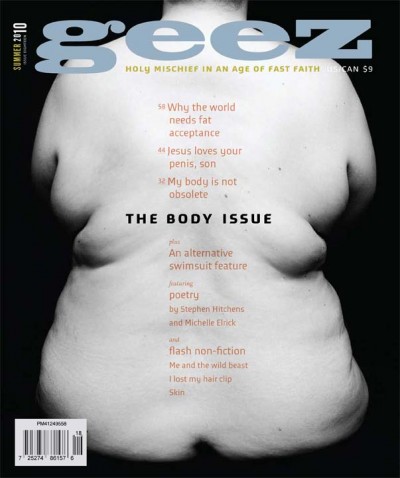Olympic Accountability
Dave Diewert is a sessional lecturer at Regent College in Vancouver, B.C., and the founder and co-ordinator of Streams of Justice , a network of Christian activists that focuses on solidarity, resistance and liberation. Geez editor Kurt Armstrong asked Dave for some of his thoughts on the Olympics, the media and activism.
Geez: There were some pretty gloomy predictions about what might happen to people in the Downtown Eastside (DTES) during the Olympics – mass roundups, mass incarceration, that sort of thing. How did it actually play out for people?
Dave Diewert: Things did look precarious, especially with the Assistance to Shelter Act, which gave the Minister of Housing power to remove homeless people to shelters during inclement weather. But the bad weather didn’t appear. It was like spring here, which wasn’t good for the games but good for the people of the DTES. The groups opposing the Olympics were vigilant around oppressive legislation and policing tactics, and this kept authorities in check. I’m sure the authorities would deny it, but I think it is true. There were some arrests for outstanding bylaw violations for minor offences, and there may have been harassment and displacement, but nothing on a massive scale.
Different events kept the DTES vibrant and energized. The 3rd Annual Poverty Olympics was a wonderful community event that brought together creative celebration and critique of the games. And with 400 people, it was the largest turnout yet. The DTES community blocked the Olympic Torch Relay as it came through their neighbourhood, a clear demonstration of communal strength, and the 19th Annual Women’s Memorial March hit record numbers, about 4,000. It wasn’t an anti-Olympic event, but organizers had to fight the city and Olympic officials to keep the usual route, which was on an official Olympic corridor.
The Olympic Tent Village lasted throughout the games for almost three weeks beyond. The village was established on land owned by a major developer (Concord Pacific) who had leased it to the Vancouver Olympic Committee (VANOC) and became home to dozens of homeless folks from the neighbourhood and activist allies. The central messages were: end homelessness, stop gentrification and cease the criminalization of low-income people. It demonstrated the strength of the community and the collective spirit of resistance and care.
Geez: What did you think of the media coverage of the protests and resistance during the Olympics?
Diewert: The opening day rally and march called “Take Back the City,” which had around 4,000 people in attendance, received little coverage. But the 2010 Heart Attack action got lots of coverage, mostly stirring up public outrage for some minor property damage that happened. The media seemed unable or unwilling to offer a sound explanation for the objective of the action – blocking traffic to Whistler – and the diverse tactics employed, of which property damage was only one part.
They presented it as vandalism by angry youth rather than a tactic of disruption with clear symbolic significance. Regardless of how one feels about activist tactics, the media’s coverage was irresponsible, promoting disgust toward the protesters rather than an understanding of the rationale of the action. Needless to say, nothing of any significance was reported in the media about the hundreds of arrests made for public disturbance, property damage or injury to police officers by drunken, brawling sports fans. So protesters were demonized while intoxicated, aggressive fans were affirmed through media silence.
The Vancouver Media Co-op did some excellent work maintaining strong coverage of Olympic resistance actions, and the dedication of folks there was really valuable.
Geez: What are the before-and-after-the-Olympics differences in the Downtown Eastside? Is there more housing? Are things back to the way they were before the games, have things improved at all?
Diewert: Although 80 folks found housing as a result of the Tent Village action, there has not been more low-income housing generated for the area. Whether the promised units of non-market housing will go ahead at the Athlete’s Village is yet to be seen. The city just completed another homeless count, and the results of this are supposed help keep the shelters open. But emergency shelters aren’t housing; they just render homelessness invisible.
Gentrification is alive and well in the DTES. No doubt the Olympics brought renewed development schemes, speculative real estate ventures and accompanying policing strategies. These pose a constant threat of displacement and harassment for the majority low-income residents in the neighbourhood.
But the Olympics experience demonstrated the resilience and spirit of resistance that are present in the neighbourhood. The Carnegie Community Action Project has been working tirelessly on a community visioning process that brings to the fore the voices and perspectives of the low-income residents. A newly formed Neighborhood Council will help articulate the demands and concerns of the community. It is inspiring to see how the Olympics sparked renewed energy and commitment to that area of the city from individuals, groups and allies. We’ll see how it all plays out.
Send submissions for the Culturosities section to culturosities@geezmagazine.org.



Sorry, comments are closed.